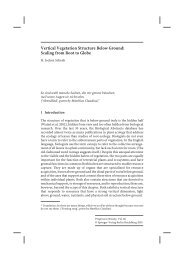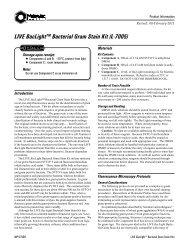Landscape Evolution at an Active Plate Margin - Biological Science ...
Landscape Evolution at an Active Plate Margin - Biological Science ...
Landscape Evolution at an Active Plate Margin - Biological Science ...
Create successful ePaper yourself
Turn your PDF publications into a flip-book with our unique Google optimized e-Paper software.
144.1 (3.0) View right (northeast) of recessional<br />
shorelines. Historically the lake was 30 to 50 feet<br />
deep, deeper in the Pleistocene.<br />
145.7 (1.6) Continue past a left (west) turn to Lubken<br />
C<strong>an</strong>yon Road.<br />
147.0 (1.3) Left (west) is Diaz Lake, a sag pond cre<strong>at</strong>ed<br />
between the Lone Pine <strong>an</strong>d Owens Valley faults<br />
during the 1872 earthquake. The sag pond was empty<br />
in 1955 <strong>an</strong>d did not hold w<strong>at</strong>er until 1969. The name<br />
Diaz comes from Eleuterio <strong>an</strong>d Rafael Diaz, who were<br />
the unfortun<strong>at</strong>e owners of the r<strong>an</strong>ch th<strong>at</strong> became<br />
the site of the lake following the earthquake (Clark,<br />
1997). The Alabama Hills west of Lake Diaz form<br />
a prominent, 10 mile long, north-trending ridge of<br />
Cretaceous gr<strong>an</strong>ite <strong>an</strong>d Jurassic metavolc<strong>an</strong>ic <strong>an</strong>d<br />
metasedimentary rocks separ<strong>at</strong>ed from the main Sierra<br />
massif by a frontal fault (the Independence fault).<br />
As such, they are only one of two areas of arc-rel<strong>at</strong>ed<br />
rocks within the valley. The other arc-rel<strong>at</strong>ed rocks<br />
are the Poverty Hills, 35 miles to the north.<br />
148.3 (1.3) Continue on Hwy 395 past a junction on<br />
the right with Hwy 136 to De<strong>at</strong>h Valley.<br />
149.6 (1.3) Enter Lone Pine.<br />
149.8 (0.2) A movie museum is on the left (west).<br />
150.1 (0.3) TURN LEFT (west) <strong>at</strong> the traffic light<br />
onto Whitney Portal Road.<br />
150.5 (0.4) Intersection of Tuttle Creek <strong>an</strong>d Fairb<strong>an</strong>ks<br />
Road. Portagee Joe Creek campground is 0.1 mile<br />
south (left).<br />
150.7 (0.2) TURN RIGHT just beyond the LADWP<br />
aqueduct.<br />
150.9 (0.2) Cross two tree-lined creeks, immedi<strong>at</strong>ely<br />
TURN RIGHT, <strong>an</strong>d BEAR LEFT (north) on a dirt<br />
road.<br />
151.1 (0.2) PARK <strong>an</strong>d WALK to the fault scarp (Fig.<br />
1-9).<br />
STOP 1-5 (N 36°36’19.2”; W 118°04’28.9”). White<br />
gr<strong>an</strong>ite debris against dark rock debris. This scarp,<br />
on the Lone Pine fault, preserves evidence of slip<br />
during the Lone Pine earthquake of March 26, 1872.<br />
The Owens Valley fault gener<strong>at</strong>ed a magnitude 7.5<br />
to 7.8 earthquake considered to be the third largest<br />
historic earthquake in the conterminous United<br />
St<strong>at</strong>es (Ellsworth, 1990; Be<strong>an</strong>l<strong>an</strong>d <strong>an</strong>d Clark, 1994).<br />
This rupture had both oblique-normal <strong>an</strong>d right slip<br />
displacements. Dextral displacement averaged 6.0<br />
D. R. Jessey <strong>an</strong>d R. E. Reynolds<br />
Figure 1-9. View looking to the north along the Lone Pine fault. [D.<br />
R. Jessey photo]<br />
± 2.0 m with 1.0 ± 0.5 m of normal slip (Bacon <strong>an</strong>d<br />
Pezzop<strong>an</strong>e, 2007) Surface rupture length has been<br />
measured <strong>at</strong> 110 km (Be<strong>an</strong>l<strong>an</strong>d <strong>an</strong>d Clark, 1994). This<br />
particular scarp has been extensively studied (Oakeshott,<br />
et al., 1972, Be<strong>an</strong>l<strong>an</strong>d <strong>an</strong>d Clark, 1987, Lubetkin<br />
<strong>an</strong>d Clark, 1988). It lies near the southern extent of<br />
the 1872 surface break.<br />
The Owens Valley fault near Lone Pine consists of the<br />
main trace <strong>an</strong>d a secondary br<strong>an</strong>ch. The “main” fault<br />
extends along the western side of the town of Lone<br />
Pine forming the east side of Lake Diaz to the south.<br />
The discontinuous secondary trace lies approxim<strong>at</strong>ely<br />
1.0-1.5 kilometers to the west <strong>at</strong> the base of the<br />
Alabama Hills. This secondary fault was termed the<br />
Lone Pine fault by Lubetkin (1980). While both faults<br />
ruptured during the 1872 earthquake, the Lone Pine<br />
fault experienced right-oblique slip <strong>an</strong>d the Owens<br />
Valley fault only dextral shear.<br />
Following the 1872 earthquake researchers initially<br />
focused on vertical displacement reporting 12–18 feet<br />
of offset (Hobbs, 1910). It wasn’t until the 1960s th<strong>at</strong><br />
the right-slip component was fully documented <strong>an</strong>d<br />
recognized as the domin<strong>an</strong>t component of motion<br />
(B<strong>at</strong>em<strong>an</strong>, 1961). Offset of roughly 18 feet vertically<br />
<strong>an</strong>d 40 feet horizontally was ascribed to the 1872<br />
earthquake.<br />
In the 1980s it was determined th<strong>at</strong> this scarp was, in<br />
fact, the product of three separ<strong>at</strong>e Holocene events.<br />
The dip-slip component from the 1872 earthquake<br />
was estim<strong>at</strong>ed to be 3–6 feet with horizontal slip of<br />
12–18 feet. Lubetkin <strong>an</strong>d Clark (1988) proposed three<br />
18 2009 Desert Symposium
















